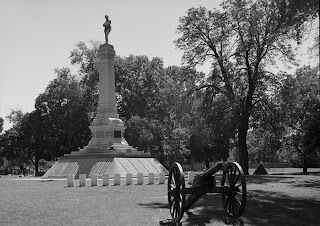Several years ago, a trip to an abandoned cemetery in southeast Kentucky led me to a small project to learn more about a young man remembered on a headstone in this seemingly forgotten place. My niece and I visited this cemetery to locate the grave of my 5th great-grandfather, Lewis Green, a Revolutionary War veteran. His marker was easy to identify, slightly outside the cemetery's perimeter.
Lewis Green Marker, courtesy of the authorIt was high summer, hot and humid as blazes. Anyone who has hiked in southeastern Kentucky knows how overgrown the area is. We could not explore deeply into the cemetery. However, our small search outside the cemetery boundaries was enough to give me a case of poison ivy.
We photographed several graves, but I did not look at the photographs until I returned home. Eventually, I examined all of them and was excited to find one that, with further research, might have a story associated with it. The stone was of a soldier who died during the Civil War.
Flooding caused the removal of some of the later burials. Eventually, workers moved all the burials to a mass grave in the Confederate Mound section of the Oak Woods Cemetery. General John C. Underwood, regional head of the United Confederate Veterans, dedicated a monument of a Confederate soldier in this section of the cemetery on May 30th, 1895. Ten thousand members of the public and President Grover Cleveland attended the ceremonies. In 1911, the Commission for Marking the Graves of Confederate Dead raised the monument above ground level and added the names of the Confederate dead, including Robert Green's.
Confederate Mound, Oakwood Cemetery, Chicago, Illinois, public domainRobert died of dysentery in the camp at age 28, one year after the date of his capture. Robert left a wife and several children behind in the hills of Kentucky, just a few miles from where the Battle of Cumberland Gap occurred. His wife applied for a pension in 1916. The information collected by the Adjutant General did not show Robert on any muster rolls, nor did he find any enlistment record. His wife, Matilda, may not have received any pension for Robert's service. Robert is my 1st cousin, four times removed, and is the grandson of Lewis Green.









Thank you for this informative post! Lewis Green is also my ancestor!
ReplyDeleteThank you. I'm glad you enjoyed it.
DeleteHi cousin, I have so many DNA matches to Lewis Green. Lots of his kin took the test.
ReplyDelete